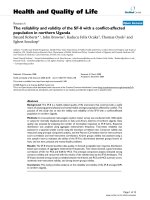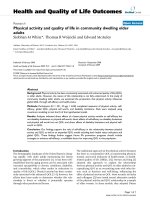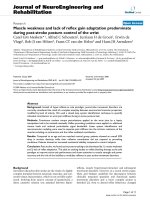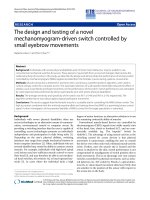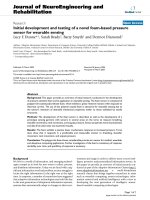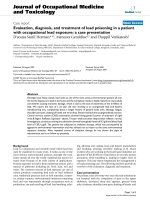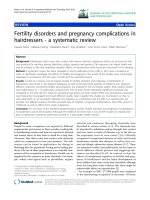Báo cáo hóa học: " Local existence and uniqueness of solutions of a degenerate parabolic system" pptx
Bạn đang xem bản rút gọn của tài liệu. Xem và tải ngay bản đầy đủ của tài liệu tại đây (308.77 KB, 11 trang )
RESEA R C H Open Access
Local existence and uniqueness of solutions
of a degenerate parabolic system
Dazhi Zhang, Jiebao Sun
*
and Boying Wu
* Correspondence: sunjiebao@126.
com
Department of Mathematics,
Harbin Institute of Technology,
Harbin 150001, PR China,
Abstract
This article deals with a degenerate parabolic system coupled with general nonlinear
terms. Using the method of regularization and monotone iteration technique, we
obtain the local existence of solutions to the Dirichlet initial boundary value problem.
We also establish the uniqueness of the solution if the reaction terms satisfy the
Lipschitz condition.
Keywords: Existence, Uniqueness, Degenerate, Monotone iteration
1 Introduction
In this article, we consider the following degenerate parabolic system
∂u
i
∂t
= u
m
i
i
+ f
i
(x, t, u
1
, u
2
), (x, t) ∈ Q
T
,
(1:1)
u
i
(
x, t
)
=0,
(
x, t
)
∈ ∂ ×
(
0, T
),
(1:2)
u
i
(
x,0
)
= u
i0
(
x
)
, x ∈
,
(1:3)
where m
i
>1,i=1,2,Q
T
= Ω ×(0,T), Ω is a bounded domain in ℝ
N
with smooth
boundary,
f
i
(
x, t, u
1
, u
2
)
∈ C
(
¯
× [0, T] ×
R
2
)
and
0 ≤ u
i0
∈ L
∞
() ∩ H
1
0
(
)
.
The coupled equations in (1.1) provide a class of quasilinear degenerate parabolic
systems. Problems of this form arise in a number of areas of science. For instance, in
models for gas or fluid flow in porous media [1-3] and for the spread of certain biolo-
gical populations [4-6]. When m
1
= m
2
= 1, the system (1.1) models the Newtonian
fluids, which is couples with Laplace equations. For various initial boundary problems
to this kind system, many articles hav e been dev oted to the existence of the solutions
and blowup properties of the solutions [7-9].
In recent years, degenerate parabolic systems are of particular interests since they
can take into account nonlinear diffusion occurring in the phenomena appearing in
the models, and have been extensively studied by many researchers (see e.g., [3,10-13]
and the references therein). The degeneracy and coupled with nonlinear terms of this
systems cause great difficulties to study them. In this article, we will establish the local
existence and uniqueness results under some special cases for the nonlinear reaction
terms. First, by making use the method of regularization and monotone iteration tech-
nique, we obtain a sequence of approximation solutions. Then a weak solution is
Zhang et al. Advances in Difference Equations 2011, 2011:12
/>© 2011 Zhang et al; li censee Springer. This is an Open Access article distributed un der the terms of t he Creative Commons At tribution
License ( which permits unrestricted use, distribution, and reproduction in any medium,
provided the original work is properly cited.
obtained as the limit of the solutions of suc h problems. Executing this program o ne
encounters two difficulties. The first is proving that the approximating problems which
are nondegenerate admits a solution, the second difficulty is to est ablish uniform
estimates for these solutions. At last, we establish the uniqueness results when the
reaction terms satisfy the Lipschitz condition.
Since the system (1.1) is degenerate whenever u
1
,u
2
vanish, there is no classical
solution in general. So we focus our main efforts on the discussion of weak solutions
in the sense of the following.
Definition 1.1. A nonnegative vector-valued function u =(u
1
,u
2
)iscalledtobea
weak solution of the problem (1.1)-(1.3) provided that
u
m
i
i
∈ L
2
(0, T; H
1
0
()) ∩ L
∞
(Q
T
)
,
∂u
m
i
i
/∂t ∈ L
2
(Q
T
)
, and
Q
T
−u
i
∂
ϕ
i
∂t
+ ∇u
m
i
i
∇ϕ
i
dxdt −
u
i0
(x)ϕ
i
(x,0)dx =
Q
T
f
i
(x, t, u
1
, u
2
)ϕ
i
dxdt
,
for any test function
ϕ
i
∈ C
2
(
¯
Q
T
)
with
i
|
∂Ω×(0, T)
=0,
i
(x, T)=0,i =1,2.The
above equation also implies
t
0
−u
i
∂ϕ
i
∂t
+ ∇u
m
i
i
∇ϕ
i
dxdt +
u
i
(x, t)ϕ
i
(x, t)dx −
u
i0
(x)ϕ
i
(x,0)d
x
=
t
0
f
i
(x, t, u
1
, u
2
)ϕ
i
dxdt,a.e.t ∈ (0, T).
Definition 1.2.Afunctionf = f(u
1
,u
2
) is said to be quasimonotone nondecreasing
(respectively, nonincreasing) if for fixed u
1
(or u
2
), f is nondecreasing (respectively,
nonincreasing) in u
2
(or u
1
).
Throughout this article, we assume f
i
(x, t, u
1
,u
2
)(i = 1, 2) satisfies the following con-
dition:
(A0) f
i
(x, t, u
1
,u
2
)(i = 1, 2) is quasimonotonically nondecreasing for u
1
,u
2
.
(A1) There exists a nonnegative function g(u) Î C
1
(ℝ) such that
f
i
(x, t, u
1
, u
2
)
≤ min
g(u
1
), g(u
2
)
for all (x, t) ∈ Q
T
, u
1
, u
2
∈ R
.
2 Existence and uniqueness
In this section, we show the local existence and uniqueness of weak solutions of (1.1)-
(1.3). First, we show the local existence results.
Theorem 2.1. Assume (A0), (A1) hold, then there exists a constant T
1
Î [0, T] such
that (1.1)-(1.3) admits a solution (u
1
,u
2
) in
Q
T
1
.
Proof. Due to the degener acy of the system (1.1), we c onsider the following regular -
ized problem
∂
u
i
∂
t
=div((m
i
u
m
1
−1
i
+ ε)∇u
i
)+f
iε
(x, t, u
1
, u
2
), (x, t) ∈ Q
T
,
(2:1)
u
i
(
x, t
)
=0,
(
x, t
)
∈ ∂ ×
(
0, T
),
(2:2)
Zhang et al. Advances in Difference Equations 2011, 2011:12
/>Page 2 of 11
u
i
(
x,0
)
= u
i0ε
(
x
)
, x ∈
,
(2:3)
where
f
iε
∈ C
1
(
¯
× [0, T] × R
2
)
; f
iε
® f
i
uniformly on bounded subset s of
¯
×
[
0, T
]
× R
2
,andf
iε
satisfies the assumptions (A0), (A1),
u
i0ε
(x) ∈ C
∞
0
(
)
,
u
m
i
i0
ε
→ u
m
i
i0
,
u
m
i
i0
ε
→ u
m
i
i0
, strongly in
W
1,2
0
(
)
as ε ® 0.
Now we will prove that the regularized problem (2.1)-(2.3) admits a classical solu-
tion. Construct a sequence
{(u
(k)
1ε
, u
(k)
2ε
)}
∞
k
=
1
from the following iteration process
∂u
(k)
i
∂t
− div((m
i
(u
(k)
i
)
m
i
−1
+ ε)∇u
(k)
i
)=f
iε
(x, t, u
(k−1)
1ε
, u
(k−1)
2ε
), (x, t) ∈ Q
T
,
(2:4)
u
(k)
i
ε
(x, t)=0, (x, t) ∈ ∂ × (0, T)
,
(2:5)
u
(k)
i0
ε
(x,0) =u
i0ε
(x), x ∈
,
(2:6)
with a suitable initial value
(u
(0)
1
ε
, u
(0)
2
ε
)
, i =1,2.Byclassicalresultsin[14],thepro-
blem (2.4)-(2.6) admits a classical solution
(u
(k)
1
ε
, u
(k)
2
ε
)
for fixed k and ε when
(u
(k
−1
)
1
ε
, u
(k
−1
)
2
ε
)
is smooth. The choice of the initial iteration value which will be
obtained by the quasimonotone property of (f
1
,f
2
) would be cruc ial to ensure that the
above sequence converges to a solution of the generalized problem.
Let
(u
−
(0)
1
ε
(x, t), u
−
(0)
2
ε
(x, t)) = (inf
{u
10ε
(x)},inf
{u
20ε
(x)}
)
,and
(u
−
(1)
1
ε
, u
−
(1)
2
ε
)
be a classical
solution of the following problem
∂u
−
(1)
i
∂t
− div((m
i
(u
−
(1)
i
)
m
i
−1
+ ε)∇u
−
(1)
i
)=f
iε
(x, t, u
−
(0)
1ε
, u
−
(0)
2ε
), (x, t) ∈ Q
T
,
u
−
(1)
iε
(x, t)=0, (x, t) ∈ ∂ × (0, T)
,
u
−
(1)
i0ε
(x,0) =u
i0ε
(x) ≥ u
−
(0)
iε
(x), x ∈ .
By the comparison theorem [15], we have
u
−
(1)
1
ε
≥ u
−
(0)
1
ε
, u
−
(1)
2
ε
≥ u
−
(0)
2
ε
.
Then the quasimonotone nondecreasing property of f
iε
shows that
f
1ε
(x, t, u
−
(1)
1ε
, u
−
(1)
2ε
) ≥ f
1ε
(x, t, u
−
(0)
1ε
, u
−
(1)
2ε
) ≥ f
1ε
(x, t, u
−
(0)
1ε
, u
−
(0)
2ε
)
,
f
2ε
(x, t, u
−
(1)
1
ε
, u
−
(1)
2
ε
) ≥ f
2ε
(x, t, u
−
(1)
1
ε
, u
−
(0)
2
ε
) ≥ f
2ε
(x, t, u
−
(0)
1
ε
, u
−
(0)
2
ε
)
.
Then we can also obtain a classical solution
(u
−
(
2
)
1
ε
, u
−
(
2
)
2
ε
)
from (2.4)-(2.6) when k =2,
and
u
−
(2)
1
ε
≥ u
−
(1)
1
ε
, u
−
(2)
2
ε
≥ u
−
(1
)
2
ε
. So we can obtain a nondecreasing sequence
u
−
(0)
iε
≤ u
−
(1)
iε
≤ u
−
(2)
iε
≤ ···≤ u
−
(k)
iε
≤ ···
.
With the similar method, by setting
(
¯
u
(0)
1ε
(x, t),
¯
u
(0)
2ε
(x, t)) = (sup
Q
T
{u
10ε
(x)} ,sup
Q
T
{u
20ε
(x)}
)
,
we obtain a classical solution
(
¯
u
(
1
)
1
ε
,
¯
u
(
1
)
2
ε
)
of the following problem
Zhang et al. Advances in Difference Equations 2011, 2011:12
/>Page 3 of 11
∂
¯
u
(
1
)
i
∂t
− div((m
i
(
¯
u
(1)
i
)
m
i
−1
+ ε)∇
¯
u
(1)
i
)=f
iε
(x, t,
¯
u
(0)
1ε
,
¯
u
(0)
2ε
), (x, t) ∈ Q
T
,
¯
u
(1)
iε
(x, t)=0, (x, t) ∈ ∂ × (0, T)
,
¯
u
(1)
i0ε
(x,0) =u
i0ε
(x) ≤
¯
u
(0)
iε
(x), x ∈ ,
and
¯
u
(1)
1
ε
≤
¯
u
(0)
1
ε
,
¯
u
(1)
2
ε
≤
¯
u
(0)
2
ε
.
And the quasimonotone nondecreasing property of f
iε
also shows that
¯
u
(0)
iε
≥
¯
u
(1)
iε
≥
¯
u
(2)
iε
≥ ···≥
¯
u
(k)
iε
≥ ···
.
Now we show
u
−
(0)
iε
≤ u
−
(1)
iε
≤ u
−
(2)
iε
≤···≤u
−
(k)
iε
≤ u
−
(k+1)
iε
≤
¯
u
(k+1)
iε
≤
¯
u
(k)
iε
≤ ···≤
¯
u
(2)
iε
≤
¯
u
(1)
iε
≤
¯
u
(0)
iε
.
(2:7)
It is obvious that
u
−
(0)
iε
≤
¯
u
(0
)
iε
. Assume that
u
−
(k)
iε
≤ u
−
(k
)
iε
,wejustneedtoprovethat
u
−
(k
+1
)
iε
≤ u
−
(k
+1
)
iε
. Since f
iε
is quasimonotone nondecreasing, we have
f
1ε
(x, t, u
−
(k)
1ε
, u
−
(k)
2ε
) ≤ f
1ε
(x, t,
¯
u
(k)
1ε
, u
−
(k)
2ε
) ≤ f
1ε
(x, t,
¯
u
(k)
1ε
,
¯
u
(k)
2ε
)
,
f
2ε
(x, t, u
−
(k)
1
ε
, u
−
(k)
2
ε
) ≤ f
2ε
(x, t, u
−
(k)
1
ε
,
¯
u
(k)
2ε
) ≤ f
2ε
(x, t,
¯
u
(k)
1ε
,
¯
u
(k)
2ε
)
.
From the iteration equations
∂u
−
(k+1)
i
∂t
− div((m
i
(u
−
(k+1)
i
)
m
1
−1
+ ε)∇u
−
(k+1)
i
)=f
iε
(x, t, u
−
(k)
1ε
, u
−
(k)
2ε
), (x, t) ∈ Q
T
,
∂
¯
u
(k+1)
i
∂t
− div((m
i
(
¯
u
(k+1)
i
)
m
1
−1
+ ε)∇
¯
u
(k+1)
i
)=f
iε
(x, t,
¯
u
(k)
1ε
,
¯
u
(k)
2ε
), (x, t) ∈ Q
T
,
u
−
(k+1)
iε
(x, t)=0=
¯
u
(k+1)
iε
(x, t), (x, t) ∈ ∂ × (0, T)
,
u
−
(k+1)
i0ε
(x,0) =u
i0ε
(x)=
¯
u
(k+1)
iε
(x,0), x ∈ ,
and the comparison theorem, we have
u
−
(k
+1
)
iε
≤ u
−
(k
+1
)
iε
. Further we can obtain (2.7).
Let
(u
(k)
1ε
, u
(k)
2ε
)=(u
−
(k)
1
ε
, u
−
(k)
2
ε
)
, then
{(u
(k)
1ε
, u
(k)
2ε
)}
∞
k
=
1
is a nondecreasing bounded sequence.
Then there exist functions u
iε
(i = 1, 2) such that
lim
k
→
∞
u
(k)
iε
= u
iε
,a.e.inQ
T
.
(2:8)
The continuity of function f
iε
(i = 1, 2) also shows that
lim
k
→
∞
f
iε
(x, t, u
(k)
1ε
, u
(k)
2ε
)=f
iε
(x, t, u
1ε
, u
2ε
), a.e. in Q
T
.
(2:9)
Therefore, we claim that there exist T
1
Î (0,T] and a positive constant M (indepen-
dent of ε and k), such that for all k,
|
u
(k)
iε
|
L
∞
(Q
T
1
)
≤ M, i =1,2
.
(2:10)
Zhang et al. Advances in Difference Equations 2011, 2011:12
/>Page 4 of 11
Let
v
±
i
(t
)
be the solutions of the ordinary differential equations
dv
±
i
(t )
dt
= ±g(v
i
), v
±
i
(0) = ±|u
i0
|
L
∞
()
, i =1,2
.
The results in [16] show that there exists
T
∗
i
∈ (0, T
)
, i =1,2,suchthat
v
±
i
(t
)
exists
on
[0, T
∗
i
]
with
T
∗
i
depends only on
|
u
i0
|
L
∞
(
)
. By the comparison theorem, we have
u
(k)
iε
(x, t)
≤ max{v
+
i
(t ), −v
−
i
(t )}, i =1,2
.
Then by setting
T
1
=
1
2
min{T
∗
1
, T
∗
2
}
and
M =max{v
+
i
(T
1
), −v
−
i
(T
1
)
}
, we obtain (2.10).
Nowweshowthat
(u
(k)
i
ε
)
m
i
+ εu
(k)
i
ε
u
m
i
i
ε
+ εu
iε
in
L
2
(0, T
1
; H
1
0
()
)
,
(u
(k)
i
ε
)
m
i
t
(u
m
i
i
ε
)
t
, u
(k)
i
ε
t
u
iε
t
in
L
2
(Q
T
1
)
as k ® ∞,where⇀ stands for weak
convergence.
Multiplying (2.4) by
(u
(k)
iε
)
m
i
+ εu
(k
)
iε
and integrating over
Q
T
1
= × (0, T
1
)
, we have
Q
T
1
u
(k)
iε
m
i
+ εu
(k)
iε
∂u
(k)
iε
∂t
dt dx +
Q
T
1
∇(u
(k)
iε
)
m
i
+ ε∇u
(k)
iε
2
dxdt
=
Q
T
1
f
iε
(x, t, u
(k−1)
1ε
, u
(k−1)
2ε
)
u
(k)
iε
m
i
+ εu
(k)
iε
dxdt
,
that is
Q
T
1
∇(u
(k)
iε
)
m
i
+ ε∇u
(k)
iε
2
dxdt
=
Q
T
1
f
iε
(x, t, u
(k−1)
1ε
, u
(k−1)
2ε
)
u
(k)
iε
m
i
+ εu
(k)
iε
dxdt
−
1
m
i
+1
u
(k)
iε
(x, T
1
)
m
i
+1
−
u
(k)
iε
(x,0)
m
i
+1
d
x
−
1
2
u
(k)
iε
(x, T
1
)
2
−
u
(k)
iε
(x,0)
2
dx.
Then by (2.10) and the property of f
iε
, we have
Q
T
1
∇(u
(k)
iε
)
m
i
+ ε∇u
(k)
iε
2
dxdt ≤ C
,
(2:11)
where C is a constant independent of k, ε.
Multiplying (2.4) by
∂
∂
t
u
(k)
iε
m
i
+ εu
(k)
iε
and i ntegrating over
Q
T
1
,byYoung’ s
inequality we have
Zhang et al. Advances in Difference Equations 2011, 2011:12
/>Page 5 of 11
Q
T
1
∂u
(k)
iε
∂t
∂
u
(k)
iε
m
i
∂t
dxdt + ε
Q
T
1
∂u
(k)
iε
∂t
2
dxdt
= −
1
2
T
1
0
∂
∂t
∇(u
(k)
iε
)
m
i
+ ε∇u
(k)
iε
2
dxdt + ε
Q
T
1
f
iε
(x, t, u
(k−1)
1ε
, u
(k−1)
2ε
)
∂u
(k)
iε
∂t
dxdt
+
Q
T
1
f
iε
(x, t, u
(k−1)
1ε
, u
(k−1)
2ε
)
∂
u
(k)
iε
m
i
∂t
dxdt
= −
1
2
T
1
0
∂
∂t
∇(u
(k)
iε
)
m
i
+ ε∇u
(k)
iε
2
dxdt + ε
Q
T
1
f
iε
(x, t , u
(k−1)
1ε
, u
(k−1)
2ε
)
∂u
(k)
iε
∂t
dxdt
+
2m
i
m
i
+1
Q
T
1
f
iε
(x, t, u
(k−1)
1ε
, u
(k−1)
2ε
)
u
(k)
iε
(m
i
−1)/2
∂
u
(k)
iε
(m
i
+1)/2
∂t
dxdt
≤
1
2
∇
u
(k)
i0ε
m
i
+ ε∇u
(k)
i0ε
2
dx −
1
2
∇
u
(k)
iε
(x, T
1
)
m
i
+ ε∇u
(k)
iε
(x, T
1
)
2
dx
+
1
4
Q
T
1
f
2
iε
(x, t, u
(k−1)
1ε
, u
(k−1)
2ε
)dxdt +
m
i
2
Q
T
1
f
2
iε
(x, t, u
(k−1)
1ε
, u
(k−1)
2ε
)
u
(k)
iε
m
i
−1
dxd
t
+
2m
i
(m
i
+1)
2
Q
T
1
∂
∂t
u
(k)
iε
(m
i
+1)/2
2
dxdt + ε
2
Q
T
1
∂u
(k)
iε
∂t
2
dxdt.
Noticing that the first term of the left side of the above inequality can be rewritten as
Q
T
1
∂u
(k)
iε
∂t
∂(u
(k)
iε
)
m
i
∂t
dxdt =
4m
i
(m
i
+1)
2
Q
T
1
∂
∂t
u
(k)
iε
(m
i
+1)/2
2
dxdt
.
Then we have
2m
i
(m
i
+1)
2
Q
T
1
∂
∂t
u
(k)
iε
(m
i
+1)/2
2
dxdt +(ε − ε
2
)
Q
T
1
∂u
(k)
iε
∂t
2
dxdt
≤
1
2
∇
u
(k)
i0ε
m
i
+ ε∇u
(k)
i0ε
2
dx +
1
4
Q
T
1
f
2
iε
(x, t, u
(k−1)
1ε
, u
(k−1)
2ε
)dxd
t
+
m
i
2
Q
T
1
f
2
iε
(x, t, u
(k−1)
1ε
, u
(k−1)
2ε
)
u
(k)
iε
m
i
−1
dxdt.
Therefore
Q
T
1
∂
∂t
u
(k)
iε
(m
i
+1)/2
2
dxdt ≤ C
.
Zhang et al. Advances in Difference Equations 2011, 2011:12
/>Page 6 of 11
Furthermore, we can obtain
Q
T
1
∂
∂t
u
(k)
iε
m
i
2
dxdt =
4m
i
(m
i
+1)
2
Q
T
1
(u
(k)
iε
)
m
i
−1
∂
∂t
u
(k)
iε
(m
i
+1)/2
2
≤ C
,
Q
T
1
∂
∂t
u
(k)
iε
2
dxdt ≤ C.
(2:12)
Following (2.8), (2.9), (2.12) and the uniqueness of the weak limits, it is easy to know
that, as k ® ∞,
u
(k)
iε
→ u
iε
, f
iε
(x, t, u
(k)
1ε
, u
(k)
2ε
) → f
iε
(x, t, u
1ε
, u
2ε
), a.e. in Q
T
1
,
(2:13)
∂u
(k)
iε
∂t
∂u
iε
∂t
,
∂(u
(k)
iε
)
m
i
∂t
∂u
m
i
iε
∂t
,inL
2
(Q
T
1
)
,
(2:14)
where ⇀ stands for weak convergence, i = 1, 2. Furthermore (2.11) implies that there
exists
ν
s
∈ L
2
(Q
T
1
)
, s = 1, , n, such that
∂
(u
(k)
iε
)
m
i
+ εu
(k)
iε
∂x
s
ν
s
a.e. in L
2
(Q
T
1
)
.
Hence,
Q
T
1
−u
iε
∂
ϕ
i
∂t
+ ν∇ϕ
i
dxdt −
u
i0ε
(x)ϕ
i
(x,0) dx =
Q
T
1
f
i
(x, t, u
1ε
, u
2ε
)ϕ
i
dxdt
,
(2:15)
where ν =(ν
1
, , ν
n
),
ϕ
i
∈ C
2
(
¯
Q
T
1
)
with
ϕ
i
|
∂×
(
0,T
1
)
=0
,
i
(x, T
1
)=0,i =1,2.
Now for any
i
given as before, we show
Q
T
1
∇
u
(k)
iε
m
i
+ εu
(k)
iε
∇ϕ
i
dxdt =
Q
T
1
ν∇ϕ
i
dxdt,ask →∞
.
(2:16)
For any
w ∈ L
2
(0, T
1
; H
1
0
()
)
,
ζ
∈ C
1
(
¯
Q
T
1
)
,0≤ ζ ≤ 1,
ζ |
∂×
(
0,T
1
)
=0
with ζ(x, T
1
)=
0, multiplying (2.4) by
ζ
u
(k)
iε
m
i
+ εu
(k)
iε
and integrating over
Q
T
1
, we have
Q
T
1
ζ
∇
u
(k)
iε
m
i
+ εu
(k)
iε
2
dxdt
=
Q
T
1
ζ
u
(k)
iε
m
i
+ εu
(k)
iε
f
i
(x, t, u
(k−1)
1ε
, u
(k−1)
2ε
)dxdt
+
ζ (x,0)
1
m
i
+1
u
(k)
i0ε
m
i
+1
+
ε
2
(u
(k)
i0ε
)
2
dx
+
Q
T
1
1
m
i
+1
(u
(k)
iε
)
m
i
+1
+
ε
2
(u
(k)
iε
)
2
ζ
t
dxdt
−
Q
T
1
(u
(k)
iε
)
m
i
+ εu
(k)
iε
∇
(u
(k)
iε
)
m
i
+ εu
(k)
iε
∇ζ dxdt
.
(2:17)
Zhang et al. Advances in Difference Equations 2011, 2011:12
/>Page 7 of 11
Notice that
Q
T
1
ζ
∇
(u
(k)
iε
)
m
i
+ εu
(k)
iε
2
dxdt
−
Q
T
1
ζ ∇
(u
(k)
iε
)
m
i
+ εu
(k)
iε
∇w dxdt −
Q
T
1
ζ ∇w∇
(u
(k)
iε
)
m
i
+ εu
(k)
iε
− w
dxd
t
=
Q
T
1
ζ ∇
(u
(k)
iε
)
m
i
+ εu
(k)
iε
− w
∇
(u
(k)
iε
)
m
i
+ εu
(k)
iε
− w
dxdt ≥ 0,
from (2.17), we get
Q
T
1
ζ
u
(k)
iε
m
i
+ εu
(k)
iε
f
i
(x, t, u
(k−1)
1ε
, u
(k−1)
2ε
)dxdt
+
ζ (x,0)
1
m
i
+1
(u
(k)
i0ε
)
m
i
+1
+
ε
2
(u
(k)
i0ε
)
2
dx
+
Q
T
1
1
m
i
+1
(u
(k)
iε
)
m
i
+1
+
1
2
(u
(k)
iε
)
2
ζ
t
dxdt
−
Q
T
1
u
(k)
iε
m
i
+ εu
(k)
iε
∇
u
(k)
iε
m
i
+ εu
(k)
iε
∇ζ dxd t
−
Q
T
1
ζ ∇
u
(k)
iε
m
i
+ εu
(k)
iε
)
∇w dxdt −
Q
T
1
ζ ∇w∇
u
(k)
iε
m
i
+ εu
(k)
iε
− w
dxdt ≥ 0
.
Letting k ® ∞, then
Q
T
1
ζ ((u
iε
)
m
i
+ εu
iε
)f
i
(x, t, u
1ε
, u
2ε
)ϕ
i
dxdt
+
ζ (x,0)
u
m
i
+1
i0ε
m
i
+1
+
ε
2
u
2
i0ε
dx
+
Q
T
1
u
m
i
+1
iε
m
i
+1
+
1
2
u
2
iε
ζ
t
dxdt −
Q
T
1
(u
m
i
iε
+ εu
iε
)ν∇ζ dx d
t
−
Q
T
1
ζν∇w dxdt −
Q
T
1
ζ ∇w ∇(u
m
i
iε
+ εu
iε
− w)dxdt ≥ 0.
(2:18)
Set
ϕ
i
= ζ(u
m
i
iε
+ εu
iε
)
in (2.15), we obtain
Q
T
1
ζ (u
m
i
iε
+ εu
iε
)f
i
(x, t, u
1ε
, u
2ε
)dxdt
+
ζ (x,0)
u
m
i
+1
i0ε
m
i
+1
+
ε
2
u
2
i0ε
dx +
Q
T
1
u
m
i
+1
iε
m
i
+1
+
u
2
iε
2
ζ
t
dxd
t
=
Q
T
1
(u
m
i
iε
+ εu
iε
)ν ∇ζ dxdt +
Q
T
1
ζν∇(u
m
i
iε
+ εu
iε
)dxdt.
Zhang et al. Advances in Difference Equations 2011, 2011:12
/>Page 8 of 11
Substituting the above equation into (2.18), we get
Q
T
1
ζ (ν −∇w)∇(u
m
i
iε
+ εu
iε
− w)dxdt ≥ 0
.
(2:19)
Taking
w = u
m
i
iε
+ εu
iε
− δϕ
i
, δ ≥ 0 in (2.19) and then let δ ® 0, we obtain
Q
T
1
ζ (ν −∇(u
m
i
iε
+ εu
iε
))∇ϕ
i
dxdt ≥ 0
,
where
ϕ
i
∈ C
1
(
¯
Q
T
1
)
with
ϕ
i
|
∂×
(
0,T
1
)
=0
. Obviously, if we let δ ≤ 0, we can get the
inverted inequality. So we can obtain (2.16) by choosing suitable ζ,s.t.supp
i
⊂ suppζ
and ζ = 1 on supp
i
.
In summary, we have proved that u
ε
=(u
1ε
, u
2ε
) is a weak solution of (2.1)-(2.3).
Now, we will prove that the limit of u
ε
=(u
1ε
, u
2ε
) is a weak solution of (1.1)-(1.3).
Since u
ε
=(u
1ε
, u
2ε
) satisfies similar estimates as ( 2.10)-(2.12), combining the property
of f
iε
, we know that there are function s
u
m
i
i
∈ L
2
(0, T
1
; H
1
0
()
)
,
u
it
, u
m
i
it
∈ L
2
(Q
T
1
)
, i =1,
2, such that for some sub sequence of (u
1ε
, u
2ε
), denoted by itself for simplicity, when ε
® 0
u
iε
→ u
i
, f
iε
(x, t, u
1ε
, u
2ε
) → f
i
(x, t, u
1
, u
2
), a.e. in Q
T
1
,
∂u
iε
∂t
∂u
i
∂t
,
∂u
m
i
iε
∂t
∂u
m
i
i
∂t
,inL
2
(Q
T
1
).
Then a similar argument as above shows that u =(u
1
,u
2
) is a weak solution of (1.1)-
(1.3). □
The following is the uniqueness result to the solution of the system.
Theorem 2.2. Assume that f =(f
1
,f
2
) is Lipschitz continuous i n (u
1
,u
2
),then(1.1)-
(1.3) has a unique solution.
Proof. Assume that u =(u
1
,u
2
), v =(v
1
,v
2
) are two solutions of (1.1)-(1.3). Form
Definition 1, we see that
t
0
−u
i
∂ϕ
i
∂t
+ ∇u
m
i
i
∇ϕ
i
dxdt +
u
i
(x, t)ϕ
i
(x, t)dx −
u
i0
(x)ϕ
i
(x,0)d
x
=
t
0
f
i
(x, t, u
1
, u
2
)ϕ
i
dxdt,a.e.t ∈ (0, T).
(2:20)
t
0
−v
i
∂ϕ
i
∂t
+ ∇v
m
i
i
∇ϕ
i
dxdt +
v
i
(x, t)ϕ
i
(x, t)dx −
v
i0
(x)ϕ
i
(x,0)d
x
=
t
0
f
i
(x, t, v
1
, v
2
)ϕ
i
dxdt,a.e.t ∈ (0, T).
(2:21)
Zhang et al. Advances in Difference Equations 2011, 2011:12
/>Page 9 of 11
Subtracting the two equations, we get
(u
i
(x, t) − v
i
(x, t))ϕ
i
(x, t)dx
=
t
0
(u
i
− v
i
)(ϕ
it
+ (x, s)ϕ
i
)dxds +
t
0
(f
i
(x, t, u
1
, u
2
) − f
i
(x, t, v
1
, v
2
))ϕ
i
dxds
,
(2:22)
where
(x, s) ≡
1
0
m
i
(θu
i
+(1− θ)v
i
)
m
1
−1
dθ
.
Since (u
1
,u
2
)and(v
1
,v
2
)areboundedonQ
t
, it follows from m>1, F(x, s)isa
bounded nonnegative function. Thus, appropriate test function
i
maybechosen
exactly as in [[17], pp. 118-123] and combined with the Lipschitz continuity of f
i
to
obtain
|u
i
(x, t) − v
i
(x, t)|dx ≤ C
t
0
|u
1
− v
1
| + |u
2
− v
2
|dxds, i =1,2
.
where C>0 is a bounded constant. Further, we have
|u
1
(x, t) − v
1
(x, t)| + |u
2
(x, t) − v
2
(x, t)|dx ≤ C
t
0
|u
1
− v
1
| + |u
2
− v
2
|dxds
.
Combined with the Gronwall’s lemma, we see that u
i
≡ v
i
, i = 1, 2. The proof is com-
pleted. □
Acknowledgements
The authors express their deep thanks to the referees for their very helpful suggestions to improve some results in
this paper. This work is supported by “the Fundamental Research Funds for the Central Universities” (Grant No. HIT.
NSRIF. 2011006) and also by the 985 project of Harbin Institute of Technology.
Authors’ contributions
DZ and JS carried out the proof of existence, BW conceived of the study, and participated in its design and
coordination. All authors read and approved the final manuscript.
Competing interests
The authors declare that they have no competing interests.
Received: 30 November 2010 Accepted: 16 June 2011 Published: 16 June 2011
References
1. Arossox, DG, Craxdall, MG, Peletier, LA: Stabilization of solutions of a degenerate nonlinear diffusion problem. Nonlinear
Anal. 6(10), 1001–1022 (1982). doi:10.1016/0362-546X(82)90072-4
2. Bear, J: Dynamics of Fluids in Porous Media. Elsevier, New York (1972)
3. Lei, PD, Zheng, SN: Global and nonglobal weak solutions to a degenerate parabolic system. J Math Anal Appl. 324(1),
177–198 (2006). doi:10.1016/j.jmaa.2005.12.012
4. Okubo, A: Diffusion and Ecological Problems: Mathematical Models. In Biomathematics, vol. 10,Springer, Berlin,
Heidelberg, New York (1980)
5. Meinhardt, H: Models of Biological Pattern Formation. Academic Press, London (1982)
6. Romanvoskii, YM, Stepanova, NV, Chernavskii, DS: Mathematical biophysics. Nauka, Moscow (1984). (in Russian)
7. Constantin, A, Escher, J, Yin, Z: Global solutions for quasilinear parabolic system. J Differ Equ. 197(1), 73–84 (2004).
doi:10.1016/S0022-0396(03)00165-7
8. Dickstein, F, Escobedo, M: A maximum principle for semilinear parabolic systems and application. Nonlinear Anal. 45(7),
825–837 (2001). doi:10.1016/S0362-546X(99)00419-8
9. Pierre, M, Schmidt, D: Blowup in reaction diffusion systems with dissipation of mass. SIAM J Math Anal. 28(2), 259–269
(1997). doi:10.1137/S0036141095295437
Zhang et al. Advances in Difference Equations 2011, 2011:12
/>Page 10 of 11
10. Wang, MX, Wei, YF: Blow-up properties for a degenerate parabolic system with nonlinear localized sources. J Math Anal
Appl. 343(2), 621–635 (2008). doi:10.1016/j.jmaa.2008.01.073
11. Cui, ZJ, Yang, ZD: Boundedness of global solutions for a nonlinear degenerate parabolic (porous medium) system with
localized sources. Appl Math Comput. 198(2), 882–895 (2008). doi:10.1016/j.amc.2007.09.037
12. Litcanu, G, Morales-Rodrigo, C: Global solutions and asymptotic behavior for a parabolic degenerate coupled system
arising from biology. Nonlinear Anal. 72(1), 77–98 (2008)
13. Le, D: Higher integrability for gradients of solutions to degenerate parabolic systems. Discr Contin Dyn Syst. 26(2),
597–608 (2010)
14. Ladyzenskaja, OA, Solonnikov, VA, Ural’ceva, NN: Linear and quasilinear equations of parabolic type. Translation of
Mathematical Monographs. American Mathematical Society, Providence. 23 (1968)
15. Friedman, A: Partial Differential Equations of Parabolic Type. Prentice-Hall Inc, Engle-wood Cliffs (1964)
16. Coddington, E, Levinson, N: Theory of Ordinary Differential Equations. McGraw-Hill, New York (1955)
17. Anderson, JR: Local existence and uniqueness of solutions of degenerate parabolic equations. Commun Partial Differ
Equ. 16, 105–143 (1991). doi:10.1080/03605309108820753
doi:10.1186/1687-1847-2011-12
Cite this article as: Zhang et al.: Local existence and uniqueness of solutions of a degenerate parabolic system.
Advances in Difference Equations 2011 2011:12.
Submit your manuscript to a
journal and benefi t from:
7 Convenient online submission
7 Rigorous peer review
7 Immediate publication on acceptance
7 Open access: articles freely available online
7 High visibility within the fi eld
7 Retaining the copyright to your article
Submit your next manuscript at 7 springeropen.com
Zhang et al. Advances in Difference Equations 2011, 2011:12
/>Page 11 of 11



